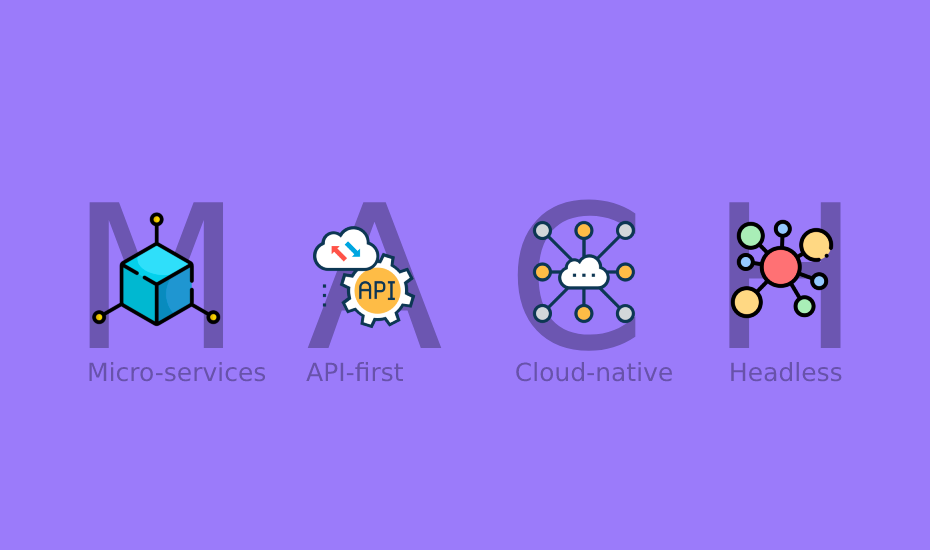The eCommerce industry, like ever, is at the forefront of innovation. The modern eCommerce platforms require a high level of control and agility to meet the customer needs for today and the future. Future-oriented organizations have already begun shifting from the monolithic approach to headless software architecture. MACH Architecture is a set of technical tools put together to make the most out of next-generation headless eCommerce platforms.
The MACH foundation — microservices-based, API-first, cloud-native, and headless — creates a genuinely open, modular environment that allows businesses to embrace innovation and adapt to change faster and with less risk than ever before.
Let’s have a quick overview of these 4 pillars of MACH. Even though these technologies cover different aspects of the eCommerce ecosystem, all are connected in some way or another.
Mico-services
Micro-services are stand-alone applications created for a specific business purpose. They are independently designed, developed & managed by their respective team.
It’s exclusively developed to perform a single task like product search, product reviews, checkout, wishlists, and more.
Most of the existing eCommerce ecosystems are monolithic which makes the platform less scalable and reusable. But as microservices can be changed independently they allow for seamless upgrades and higher fault tolerance.
API-first
In MACH, all the application functionality is exposed through APIs, making it possible for different applications to interact with each other. Of Course, if you are building your application with microservices, you will have to follow an API-first approach.
The top API query languages are REST and GraphQL. GraphQL has some advantages when it comes to microservices and is developed to cope with the need for more flexibility and efficiency. It solves many of the shortcomings and inefficiencies that developers experience when interacting with REST APIs.
Cloud-native
Cloud-native is an approach for building applications as micro-services and running them on containerized and dynamically orchestrated platforms that fully exploit the advantages of the cloud computing model.
Cloud-native applications are polyglot. Services use a variety of languages, runtimes, and frameworks.
Headless
A headless setup decouples the frontend and backend of your e-commerce solution. This provides the ability to create custom frontend experiences and to use a unique user interface for every channel allowing enterprises to remain framework agnostic.
Advantages of MACH over Monolithic Approach
Earlier monolithic systems were the only option for Ecommerce platforms. These all-in-one platforms offered a one-size-fits-all approach to eCommerce website development. However, as time goes on, many brands have experienced challenges and issues with these all-in-one structures.
The following are the top 10 advantages of MACH over monolithic eCommerce platforms,
1. MACH Architectures are easily adaptable
MACH supports composable commerce in which every component is pluggable, scalable, replaceable, and can be continuously improved through agile development to meet evolving business requirements. Take advantage of the best tech on the market and create a best-of-breed approach for your business to build your custom solution instead of being limited. Moreover, since each microservice is self-contained, you could replace any of them with a custom or third-party service.
Customer behavior can change fast and businesses need to be ready to adapt in an instant and have the technology to follow suit.
Case in point: COVID-19. Customers’ purchasing behaviors were drastically altered by the epidemic, and only organizations with MACH architecture quickly pivot to accommodate such changes. MACH-based commerce can quickly adapt to the latest trends, touchpoints, technologies, and pandemics, as well as meet the ever-changing needs of customers.
2. Automatic Upgrades
Since each microservices can be changed independently, there is no technical need to package new features, patches, updates, and upgrades into more significant releases for rollout.
Never worry about disruptive upgrades that seem like re-platforming projects in themselves, ever again. With MACH architecture, all releases are automatic and non-breaking.
3. Pay for what you actually use
Before the subscription model, enterprise software customers had to make hefty upfront software licensing purchases, which were frequently accompanied by annual maintenance and support fees.
MACH architecture is inherently flexible and supports composable commerce, allowing you to customize the commerce solution you want and pay for only the tools you need while showcasing what makes your brand unique.
4. Best of breed technology
MACH architecture enables you to use the most advanced technology available. You don’t have to settle with subpar add-ons that come with software suites any longer.
Because of its composable nature, MACH can also help preserve existing functionality that you’ve invested in and are happy with
5. Faster time to market
Companies may improve their customer experiences by rolling out their offerings considerably faster with headless commerce, a vital component of MACH because they don’t have to perform time-consuming and complicated backend system updates. In a nutshell, headless commerce allows businesses to innovate when, where, and how they want.
Also with microservices architecture, you can work with different parts of the product on a parallel track, which dramatically increases team productivity and accelerates software delivery, & shorten Time-to-Market.
6. High Scalability with zero rundown
Websites with MACH experience no downtime because their commerce solution is developed in the cloud, allowing them to scale up or down based on website traffic.
When it comes to large shopping days like Black Friday, Cyber Monday, and Mother’s Day, all online companies have some concerns. Will their online store go down? Will shoppers abandon their shopping carts as a result of bad website speed? How much will it cost the company? When you switch to MACH, you’ll never have to worry about these issues again because your webshop will be able to automatically scale whenever traffic on your website increases.
7. Deliver customized experiences
Because it uses the same backend and layers multiple UIs on top of it, a MACH solution makes shopping experiences possible to any device, channel, or platform whether it’s a website, a mobile device, a software platform, an automobile, a VR headset, a voice-activated device, a Jumbotron, and anything else tomorrow’s technology brings. This results in distinctive and consistent brand experiences that entice people to return.
8. Localization
Big businesses may utilize MACH design to create a modular system that allows each of their markets to operate at their own speed and develop features according to their customers’ specific requirements. This implies that digital retailers may customize their stores in each region as often as they want to reflect local preferences while maintaining a consistent brand experience. MACH also allows companies to provide their partners, vendors, and staff secure access to customize the frontend of their web stores.
9. Personalized customer experience
You can fully leverage consumer data with MACH to provide customers with personalized purchase experiences that make shopping easier and more interesting for them, ensuring that they return. One method to use this information is to produce informed, targeted promotions for each customer – you can choose which promotions are made for which customers – and personalization like this is more likely to result in a conversion.
10. Lower TCO (Total Cost of Ownership)
While brands may cite the total cost of ownership (TCO) as a major impediment to digital transformation. However, the notion that MACH systems have a higher TCO is just mistaken. Companies consider the initial investment cost to be part of the total cost of ownership (TCO), although the majority of TCO expenses are really maintenance and labor costs (usually up to 85 percent of the total “project” cost). MACH vendors’ open, cloud-native structure and on-demand pricing, along with the potential to minimize upgrade fees, actually decreases long-term expenses. In other words, MACH allows you to accomplish more at a cheaper cost.

